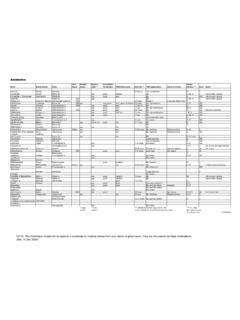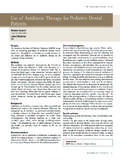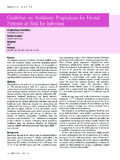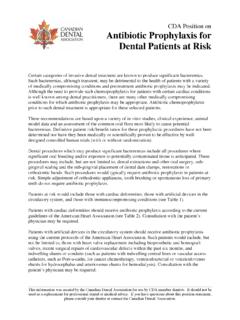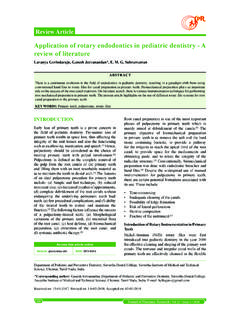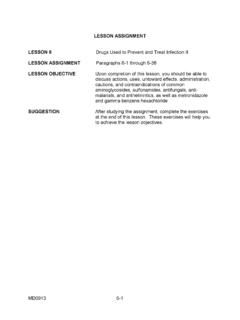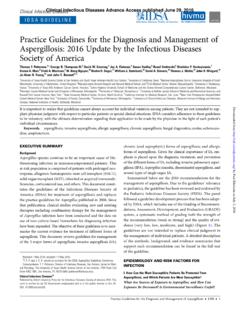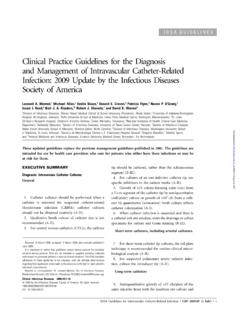Transcription of Pediatric Lyme Disease B&W - Lymepa.org
1 10/3/20041 Sunday, October 03, 2004 Pediatric lyme Disease1 Pediatric lyme DiseaseDr. Ann F CorsonSunday, October 03, 2004 Pediatric lyme Disease2 Sunday, October 03, 2004 Pediatric lyme Disease3 Risk Factors Age 10-19 Rural (suburban)vs. urban, 3x risk Single family homes Homes with yards +/- woods or attached land Homes within 100 feet of woodland Tick hosts being seen on land: deer, mice Public Health Reports 2001, Volume 116, 146-156. Risk Factors for lyme Disease in Chester Country, Pennsylvania CDC: Any child under 9 yrs at risk with many new cases LD in children under 14 yrsMMWR 1991. 42; 557-558 Sunday, October 03, 2004 Pediatric lyme Disease4 Risk Factors Having pets that come in and out, dogs or cats Outdoor activities: Horseback riding Hunting, fishing Any activity in the woods or open land or abutting high grasses including field sports, golf Activities in any outdoor area frequented by deerAnyone can be infected on any warm day of any month of the year!
2 Sunday, October 03, 2004 Pediatric lyme Disease5 Signs and Symptoms lyme Disease is truly is the great imitator of our time just as syphilis was for prior generations All organ systems of the body can be affected Onset of illness may be abrupt or indolent Symptoms are often vague and shift from day to day therefore many children are thought be maligning Children often don t understand what is wrong with their bodiesSunday, October 03, 2004 Pediatric lyme Disease6 Signs and Symptoms All children Tick bite less than 50% remember a bite, even less remember an EM rash Flu-like illness at any time of yearin 80% (parents often claim the child was never well again) Fatigue, often unrelieved by rest, in 100% Unexplained cyclical fevers Headaches occur in 90% to 100%10/3/20042 Sunday, October 03, 2004 Pediatric lyme Disease7 Signs and Symptoms All children, cont.
3 Dizziness Neck pain and stiffness in almost 90% Sore throats Swollen lymph nodes Excessive thirst Chest pains in at least 70%, some have palpitations Sense of air hunger or shortness of breath, dry cough Sunday, October 03, 2004 Pediatric lyme Disease8 Signs and Symptoms All children, cont. Abdominal pain in about 50%, can mimic acute appendicitis, mesenteric adenitis, Crohn s Disease , colitis, irritable bowel syndrome, sometimes vomiting, heartburn Urinary urgency and frequency, sudden lack of control in toilet trained child, return to or new onset enuresis. Rashes that come and go, malar rashes, newpsoriasis Sunday, October 03, 2004 Pediatric lyme Disease9 Signs and Symptoms All children, cont. Migratory arthralgias, joint pains in 50% to 100% (arthritis in only 40%), myalgias in over 80%, back ache, morning stiffness, pain at rest, muscle weakness Frequent illnesses, dark circles under their eyes, intermittent red, hot pinnae of ears Sleep disturbance in over 80% Trouble falling asleep Frequent awakenings Excessive sleepSunday, October 03, 2004 Pediatric lyme Disease10 Signs and Symptoms All children, cont.
4 Neurological symptoms are protean and can appear at any timeduring the course of infection (few weeks to over a year or more) Hypersensitivity of skin, scalp and hair Hypersensitivity to noise, light, smell Alterations of taste Poor balance and coordination Uncharacteristic behavior outbursts, mood disturbances, depression in over 90% with suicidal thoughts in over 40% Social withdrawal, decreased participationSunday, October 03, 2004 Pediatric lyme Disease11 Signs and Symptoms All children, cont. Neurological symptoms, cont. New onset phobias, anxiety disorders Oppositional behaviors Obsessive compulsive disorders Deterioration in school performance in over 90% Difficulty with concentration and attention in school with easy distractibility as well as brain fog in over 80% Word finding problems in over 80% Short term memory difficulties in over 90% New onset ADDS unday, October 03, 2004 Pediatric lyme Disease12 Signs and Symptoms All children, cont.
5 Neurological symptoms, cont. When measured with formal neuropsychiatric testing, children demonstrate defects in auditory and visual sequential processingless commonly: Movement disorders spasticity, ataxia, motor or vocal tics Cranial neuropathies, Bell s Palsy or optic nerve neuritis (can result in visual loss) Peripheral neuropathies numbness and tingling, distal parasthesias, subtle weakness10/3/20043 Sunday, October 03, 2004 Pediatric lyme Disease13 Signs and Symptoms All children, cont. Neurological symptoms, cont. Peripheral motor weakness Partial complex seizures Apparent demyelinating Disease (multiple sclerosis) Spinal cord involvement Pseudo tumor cerebri or increased intracranial pressure, papilledemaSunday, October 03, 2004 Pediatric lyme Disease14 Signs and Symptoms Adolescents Parents and teachers may think any unusual behaviors are just normal adolescence or problems such as illicit drug use or new onset psychiatric disorder Mood swings, oppositional behaviors, anxiety, depression Self mutilating behaviors Teenagers often do not report to or show parents problems with their bodiesSunday, October 03, 2004 Pediatric lyme Disease15 Signs and Symptoms Adolescents, cont.
6 Teens can also turn to alcohol and illicit drugs as self medication Teenage girls may have pelvic pain or menstrual problems, ovarian cysts, boys may have testicular pain Teens need to be aware that Borrelia may be sexually transmitted and that a fetus can acquire the infection from the mother during pregnancySunday, October 03, 2004 Pediatric lyme Disease16 Signs and Symptoms Pre-schoolers and toddlers Mood swings, sudden emotional outbursts Irritability Personality changes Regression of motor and social skills (developmental milestones) Changes in play behavior, tire easily, less activeSunday, October 03, 2004 Pediatric lyme Disease17 Signs and Symptoms Pre-schoolers and toddlers, cont. Trouble falling asleep, frequent awakenings Nightmares, new phobias, recurrence of separation anxiety Diaper rash unresponsive to normal treatment Frequent URIs, ear and throat infections, bronchitis, pneumoniaSunday, October 03, 2004 Pediatric lyme Disease18 Congenital lyme Disease Infants can be infected with Borrelia transplacentally in any stage of pregnancy and/or via mother s breast milk.
7 The co-infections: Babesia, Bartonella, Mycoplasma and perhaps even the Ehrlichias can be transmitted transplacentally to the developing , October 03, 2004 Pediatric lyme Disease19 Congenital lyme Disease Gestational Borreliosis can be associated with repeated miscarriages, fetal death in utero, fetal death at term (stillbirths), hydrocephalus, cardiovascular anomalies, intrauterine growth retardation, neonatal respiratory distress, sepsis and death, neonatal hyperbilirubinemia, cortical blindness, sudden infant death syndrome and maternal toxemia of pregnancy. Sunday, October 03, 2004 Pediatric lyme Disease20 Congenital lyme Disease Borrelia spirochetes have been found at autopsy in fetal brain, liver, adrenal glands, spleen, bone marrow, heart and placenta None of the infected tissues showed any sign of inflammation Maternal antibiotic treatment during pregnancy does not guarantee that the fetus will be free of infection Mothers with lyme Disease should be treated throughout pregnancySunday, October 03.
8 2004 Pediatric lyme Disease21 Congenital lyme Disease Infants either infected congenitally or from breast milk can have Floppiness with poor muscle tone Irritability Frequent fevers and illness early in life Joint sensitivities and body pain Skin sensitivity Gastro esophageal reflux Developmental delays Learning disabilities and psychiatric problemsSunday, October 03, 2004 Pediatric lyme Disease22 Congenital lyme Disease Infants infected congenitally can have Small windpipes (tracheomalacia) Eye problems (cataracts) Heart defects Infants bitten very early in life will have many of the same symptoms loss and decline in developmental milestonesSunday, October 03, 2004 Pediatric lyme Disease23Co-Infections Bartonella henselae: abdominal pain, headache, visual problems, significant lymph node enlargement ( mesenteric adenitis), rashes, unusual stretch marks , resistant neurological deficits, new onset seizure disorder, acute encephalitis Babesia microti(and other species): malarial like illness inside red blood cells with intermittent fevers, chills, day and night sweats, abdominal pain, profound fatigueSunday, October 03, 2004 Pediatric lyme Disease24Co-Infections Ehrlichiosis: high fevers, headaches, muscle pains, flu-like symptoms.
9 Labs can show low WBC, platelets and increased liver enzymes Mycoplasma sp.: fatigue, abdominal pain Viruses: abdominal pain, mouth sores10/3/20045 Sunday, October 03, 2004 Pediatric lyme Disease25Co-InfectionsCo-Infections are the rule, not the exception Co-Infections are often best diagnosed clinically Co-Infected patients are: sicker more likely to have failed prior treatment require longer treatment with multiple agents Co-Infections must be eradicated or Borrelia infection will persistSunday, October 03, 2004 Pediatric lyme Disease26 Evaluation Tick borne Disease is a clinical diagnosis Laboratory testing can be very difficult as many patients are serologically negative for antibodies to Borrelia despite active infection Routine labs are usually unremarkable Even the majority of spinal taps reveal normal spinal fluid Full evaluation at labs that specialize in TBD can be very helpful although negative results do not mean absence of diseaseSunday, October 03.
10 2004 Pediatric lyme Disease27 Treatment Treatment lasts as long as is necessary Until children are completely symptom free for 2 to 3 months No more cyclical Herxheimer reactions No recurrence of lyme symptoms with concomitant infections, illnesses or stresses, surgery, trauma, psychological stresses Sickest children often need many months of intravenous antibiotic therapy Children whose diagnosis and treatment are delayed may suffer considerable impairmentSunday, October 03, 2004 Pediatric lyme Disease28 School issues Teachers, school administrators, school health professionals, pediatricians, family practitioners and parents all need to be aware of the protean manifestations of TBD Mental health professionals and educators in lyme endemic areas need to recognize the possible infectious etiology of neuropsychiatric Disease in , October 03, 2004 Pediatric lyme Disease29 School issues It is imperative to identify children with persistent neuroborreliosis so they can receive appropriate medical, psychological and educational assistance.
